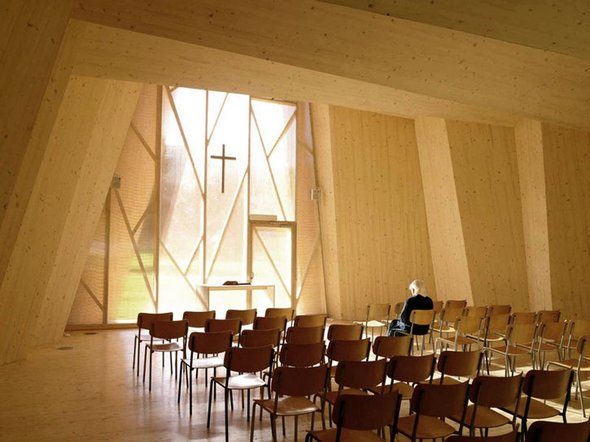I have had an interest in church architecture for some time. I have also had an aversion to much of what passes as church architecture today. It is not that I disdain all things modern but that modernity has delivered to us many church structures for which worship is almost an afterthought. The focal point of the structures has also shifted from the God whose house we gather by His invitation and favor to the people who have made His house their own, comfortable living room.
In the beginning this was fueled by the modern idea that the early Christian community did not build church buildings, did not even consider church buildings, and saw the home as the principal worship space by design (as opposed to because they had no money or legal standing to build). Herein the archeology of the last 50-60 years has proven this myth false and rendered much of the premise of modern architecture obsolete. It appears that there were church buildings used for worship -- from the beginning. It began, of course, with the discovery of Dura-Europa and a church structure dating from 232 AD. That has been the spring board for a host of other buildings built or remodeled by the Church for use in the Divine Liturgy. Some of these were found in ruins but the majority have been referenced in Christian literature of the period. A great article in the journal for the Institute for Sacred Architecture tells the story well.
The problem is that we know very little about pre-Constantinian liturgy
or Christian architecture. Yet from the scant literary evidence we do
have, we should not reject the strong probability that even in the
second century the Church owned land and built special buildings for the
community. The earliest record of the special purpose church building
seems to be from Chronicle of Arbela, a fifth-century Syrian manuscript which tells us that Bishop Isaac (Ishaq) (135-148) “had built a large well-ordered church which exists today.” The Chronicles of Edessa mention a Christian church destroyed in a city-wide flood around 201.
Around the year 225 A.D. Christians acquired a piece of public property
in a dispute with inn-keepers to build a church with the explicit
blessing of Emperor Severus Alexander, who determined “that it was
better for some sort of a god to be worshipped there than for the place
to be handed to the keepers of an eating-house.”
Thus the disconnect presumed by modern architects who assumed that a focus on the assembly was the earlier direction of church buildings. It renders some of the old assumptions as suspect. For example, you can hear the bias built in through the comments of a couple of noted modern architects:
As Father Richard Vosko surmised, “The earliest understanding of a
Christian church building implies that it is a meeting house—a place of
camaraderie, education and worship. In fact, the earliest Christian
tradition clearly held that the Church does not build temples to honor
God. That is what the civic religions did.” This notion was
put most forcefully by E.A. Sovik, writing: “It is conventionally
supposed that the reasons that Christians of the first three centuries
built almost no houses of worship were that they were too few, or too
poor, or too much persecuted. None of these is true. The real reason
that they didn’t build was that they didn’t believe in ecclesiastical
building.”
If you plan on building a structure in which the principal activity is worship, specifically the liturgy, you need to read this article. Its conclusions are inescapable for those who would force upon the Church another structure ill prepared for the Mass, with a focus upon the assembly rather than the Word and Table of the Lord, of a scale that emphasizes the place of the people, and without ornamentation designed to communicate the tenets of what is believed and confessed during the worship that takes place within its walls.
If the domestic model has no sure foundation, then the arguments erected
for rejecting the hierarchical and formal models of liturgy; for
discarding the sacramental language of Christian architecture in favor
of a functionalist and programmatic approach to building; and for
dismissing any appeals to the rich treasure trove of Catholic
architectural history and various historical styles are susceptible to
falling like a house of cards.

I do wonder what the church buildings of both congregations will look like once remodeling and expansion has been completed.
ReplyDeleteHere:
http://steadfastlutherans.org/?p=23677
And here:
http://steadfastlutherans.org/?p=23727